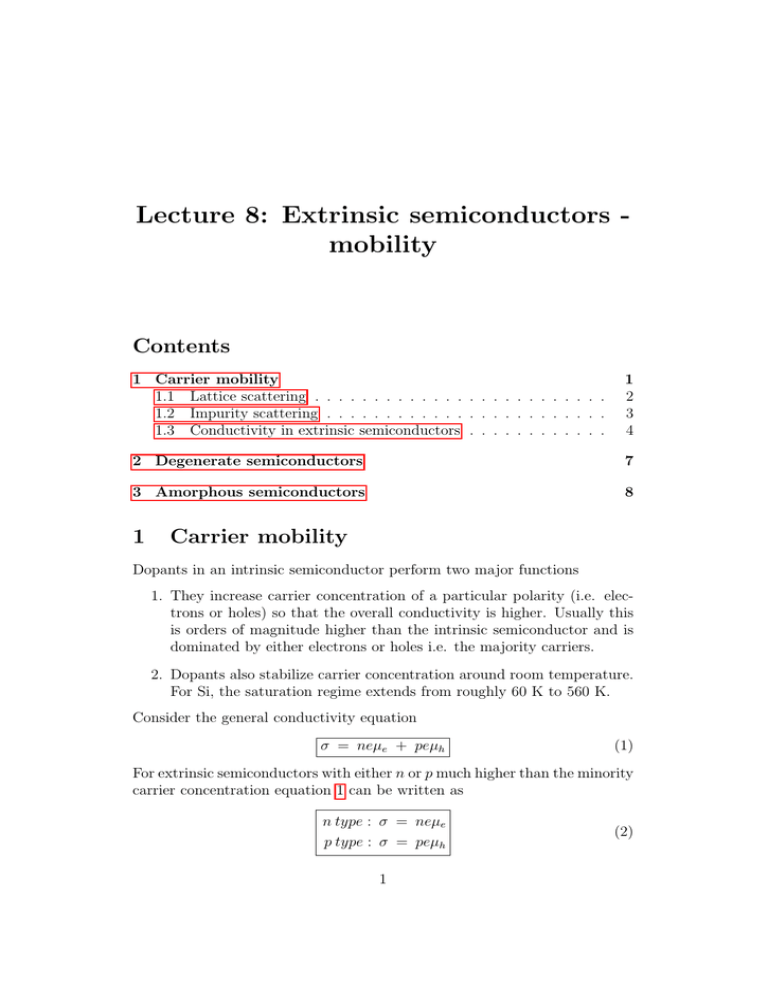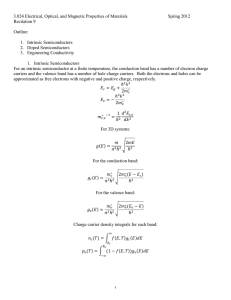Lecture 8: Extrinsic semiconductors - mobility
advertisement

Lecture 8: Extrinsic semiconductors mobility Contents 1 Carrier mobility 1.1 Lattice scattering . . . . . . . . . . . . . . . . . . . . . . . . . 1.2 Impurity scattering . . . . . . . . . . . . . . . . . . . . . . . . 1.3 Conductivity in extrinsic semiconductors . . . . . . . . . . . . 1 2 3 4 2 Degenerate semiconductors 7 3 Amorphous semiconductors 8 1 Carrier mobility Dopants in an intrinsic semiconductor perform two major functions 1. They increase carrier concentration of a particular polarity (i.e. electrons or holes) so that the overall conductivity is higher. Usually this is orders of magnitude higher than the intrinsic semiconductor and is dominated by either electrons or holes i.e. the majority carriers. 2. Dopants also stabilize carrier concentration around room temperature. For Si, the saturation regime extends from roughly 60 K to 560 K. Consider the general conductivity equation σ = neµe + peµh (1) For extrinsic semiconductors with either n or p much higher than the minority carrier concentration equation 1 can be written as n type : σ = neµe p type : σ = peµh 1 (2) MM5017: Electronic materials, devices, and fabrication µe and µh are the drift mobilities of the carriers. They are given by eτe m∗e eτh µh = ∗ mh µe = (3) The drift mobilities are a function of temperature and in extrinsic semiconductors they depend on the dopant concentration. This dependence comes from the scattering time, τe and τh , which is the time between two scattering events. Another way of writing the scattering time is in terms of a scattering cross section (S). This is given by τ = 1 S vth Ns (4) where vth is the mean speed of the electrons (thermal velocity) and Ns is the number of scatters per unit volume. The role of scatters and the effect on mobility can be considered by considering the two main types of scatters 1. Lattice atoms 2. Impurities - dopants 1.1 Lattice scattering In an intrinsic semiconductor the carrier scattering is mainly due to thermal vibrations of the lattice (Si atoms). In metals, electron-electron scattering is also important and affects the conductivity, but electron concentration in semiconductors are low so that electron-electron scattering can be ignored. For lattice scattering, if a is the amplitude of the lattice vibrations for a simple two dimensional scattering, S is just πa2 . As temperature increases, a increases and hence S increases. The second term in equation 4 is the thermal velocity (vth ). This is typically given by 23 kB T . For an electron in the conduction band this is equal to its kinetic energy so that √ 1 ∗ 3 me vth = kB T ⇒ vth ∝ T 2 2 (5) The concentration of scatters, Ns , is a constant and is independent of temperature. 2 MM5017: Electronic materials, devices, and fabrication Figure 1: Electron scattering from an ionized As donor. The scattering cross section is calculated considering the balance between the kinetic energy and the potential energy, using which a scattering radius, rc , is defined. Adapted from Principles of Electronic Materials - S.O. Kasap. So the dependence of lattice scattering time (τL ) on temperature can be given using equation 4 τL = 1 1 (− 23 ) ∝ T ∝ 1 (πa2 )vth Ns (T )(T 2 ) (6) Since the scattering time is directly proportional to the mobility, see equa3 tion 3, this means that µe is also proportional to T (− 2 ) . Thus, the effect of lattice scattering is to reduce the mobility with increase in temperature. This can be understood qualitatively by seeing that as the temperature increases the atomic vibrations increase and at the same time the electrons also travel faster. Both these effects combine to reduce the mobility. A similar argument is valid for hole scattering in intrinsic semiconductors. Despite this decrease in mobility, conductivity increases with temperature because carrier concentration increases exponentially with temperature. 1.2 Impurity scattering Impurity scattering becomes important for doped semiconductors. At room temperature the impurities are ionized, so that there is an electrostatic attraction between the electrons traveling in the lattice and the impurity, as shown in figure 1 for As doped in Si (donor). To find the scattering cross section due to the ionized impurities we can equate the kinetic energy (KE) of the electrons to the potential energy (PE) due to the ionized impurity. From 3 MM5017: Electronic materials, devices, and fabrication figure 1 the electron will not be scattered if KE dominates while scattering occurs if PE dominates. The scattering radius, rc , is the distance at which both effects are equal 3 e2 kB T = 2 4π0 r rc 2 S = πrc ∝ T −2 (7) So the scattering time due to impurities, τI , is given by equation 4 τI = 1 (πrc2 )vth NI ∝ 1 3 1 2 (T −2 )(T ) ∝ T2 (8) Again, since the scattering time is directly related to mobility, the mobility due to impurities increases with temperature, opposite to the behavior observed with the lattice. This can be understood qualitatively by considering that with increasing temperature, electrons can travel faster and this makes it easier to escape the ionized impurities. 1.3 Conductivity in extrinsic semiconductors In intrinsic semiconductors the only factor that affects mobility is the lattice scattering so that mobility always reduces with temperature. In extrinsic semiconductors there are two contributions - lattice (µL ) and the impurities (µI ). So the total mobility is given by Matthiessen’s rule, which is 1 1 1 = + µe µI µL (9) The scattering process with the lowest mobility dominates. Also, at low temperatures mobility actually increases with temperature since impurity scattering dominates, while at high temperature lattice scattering dominates. This is shown in figure 2. At low dopant concentrations lattice scattering dominates over the entire temperature range. With increasing dopant concentrations impurity scattering starts to dominate at low temperature. A similar behavior is also seen for hole mobility. Experimental measurements of electron and hole mobilities in Si, as a function of temperature, are shown in figure 3 and confirm this behavior. Also, at constant temperature the mobility decreases with increasing dopant concentration since there is greater concentration of impurities, as shown in figure 4. Looking at the the temperature dependence of conductivity, both the carrier concentration change and mobility change with temperature and influence 4 MM5017: Electronic materials, devices, and fabrication Figure 2: Mobility vs. temperature for different donor concentrations for extrinsic semiconductors. For low Nd mobility decreases with temperature, but as Nd increases at low temperature mobility actually increases. Adapted from Principles of Electronic Materials - S.O. Kasap. Figure 3: Log-log plot of experimental (a) electron mobility and (b) hole mobility vs. temperature for different dopant concentrations in Si. The applied electric field is small (low E). Source http://dx.doi.org/10.1016/00381101(77)90054-5 . 5 MM5017: Electronic materials, devices, and fabrication Figure 4: Mobility vs. dopant concentrations for both donors and acceptors. In both cases the mobility decreases with increasing dopant concentration. Adapted from Principles of Electronic Materials - S.O. Kasap. Figure 5: Conductivity dependence on T for extrinsic semiconductors. The dependence closely follows the concentration of majority carriers vs. temperature, with the effect if mobility being felt in the saturation (extrinsic) regime. Adapted from Principles of Electronic Materials - S.O. Kasap. 6 MM5017: Electronic materials, devices, and fabrication Figure 6: (a) Carrier concentration, (b) electron mobility and (c) conductivity for Si doped with 1015 cm−3 donor atoms. The increase in carrier concentration with temperature is balanced by the reduction in mobility. This is a semilog plot vs. inverse temperature (plotted in mK −1 ) and generated using MATLAB. the conductivity. The temperature dependence of conductivity is shown in figure 5. The dominating term is still the carrier concentration, due to its exponential dependence on T but the mobility term also plays a role, especially in the extrinsic regime (or saturation regime). Again, based on conductivity there is an optimal temperature range where σ is nearly constant. For Si, this is around room temperature so that doping not only gives a temperature independent carrier concentration but also conductivity. For Si doped with 1015 cm−3 donors the carrier concentration, mobility, and conductivity are plotted in figure 6. 2 Degenerate semiconductors Typical dopant concentrations are in range of ppm or ppb and form individual energy levels in the band gap. This is because ND and NA are much smaller than the effective density of states at the band edges (Nc and Nv ). These are called non-degenerate semiconductors. Under such conditions, it is possible to consider the dopants as individual atoms in the Si lattice and ignore interactions between the dopant levels. This is why dopants are shown as individual energy levels, close to the valence or conduction band, and not as an energy band. As the dopant concentration increases, the individual energy levels start to overlap so that there are no longer energy levels but energy bands. This 7 MM5017: Electronic materials, devices, and fabrication Figure 7: Degenerate (a) n and (b) p type semiconductors. The impurities form an energy band that can merge with either the valence or conduction band. The Fermi level lies within this band rather that in the band gap. Degenerate semiconductors hence have properties similar to metals. Adapted from Principles of Electronic Materials - S.O. Kasap. happens at typical dopant concentrations of 1019 and 1020 cm−3 , comparable to Nc and Nv (1020 cm−3 ). These are called degenerate semiconductors, and their energy band diagram is shown schematically in figure 7. The dopant energy levels can merge with the conduction or valence band, so that the Fermi energy lies within the band. Thus, degenerate semiconductors behave more like metals than semiconductors. Degenerate doped semiconductors are used for some opto-electronic devices like lasers due to the large carrier concentration. 3 Amorphous semiconductors For most semiconductor applications, single crystal defect free materials are used. Typical metallic impurity concentration in Si used for integrated circuit manufacture should be less than 0.1 ppb. Similarly, other defects, like dislocations, are harmful since they can modify the electronic properties of the material. The most common defect is the surface. Since the surface represents a break in the material, there will be dangling bonds at the surface. These dangling bonds produce defects states that lie at the center of the band gap. These defects states can then ‘pin’ the Fermi level at the center of the gap which will affect the carrier transport properties, especially when junctions or interfaces are formed with other materials. For Si, there is a na8 MM5017: Electronic materials, devices, and fabrication Figure 8: Energy bands in a crystalline semiconductor. (a) Simple band picture showing the band edges. (b) Density of states in the valence and conduction band. There are no energy states in the forbidden energy gap. Adapted from Physics of Semiconductor Devices - S.M. Sze. tive oxide layer (approximately 3 nm thick) that causes surface passivation and reduces the density of these dangling bonds. An amorphous semiconductor is an extreme example of the defective semiconductor. Amorphous materials have no long range order and this leads to a large density of dangling bonds, not only at the surface but also the bulk. These dangling bonds lead to localized defect states in the band gap. Figure 8 shows the energy bands in a crystalline semiconductor. There are no energy states in the band gap i.e. the forbidden energy gap. The energy band diagram for an amorphous semiconductor is shown in figure 9 and is drastically different from a crystalline semiconductor. There is the valence and conduction band, which form the extended states. They are the continuous energy states, similar to a crystallline semiconductor. Along with them the dangling bonds produce localized states that lie within the band gap. These arise due to the lack of long range order in the amorphous material. The energy gap in an amorphous semiconductor is called a mobility gap because it is not a true band gap like crystalline semiconductors. In crystals, electrons cannot exist in the band gap because there are no available energy states. But in an amorphous semiconductor since there are localized states in the band gap it is possible for electrons to exist in the band gap. The localized states usually act as traps and reduce the mobility. Conductivity 9 MM5017: Electronic materials, devices, and fabrication Figure 9: Energy bands in an amorphous semiconductor. There are extended states in the valence and conduction band. Along with that there are also localized states in the band gap. Adapted from Principles of Electronic Materials - S.O. Kasap. in these materials occurs when electron trapped in the defects states ’hop’ from one localized state to the next, called hopping conduction. Crystalline Si has a mobility of 1350 cm2 V −1 s−1 while amorphous Si (denoted a-Si:H) has a mobility as low as 1 cm2 V −1 s−1 . The notation a-Si:H means amorphous Si with hydrogen termination at the surface (to passivate surface dangling bonds). Amorphous semiconductors find applications in solar cells, image sensors, TFTs (thin film transistors) where device speed is not an important criteria but cost is. It is easier to fabricate amorphous materials than high purity and defect free single crystals and the low cost can compensate for the poorer performance. 10




